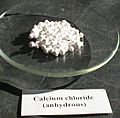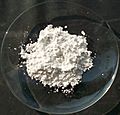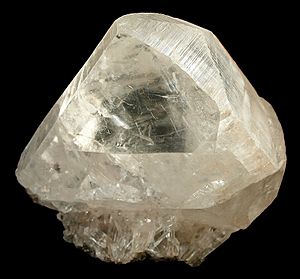Calcium facts for kids
Calcium is a chemical element. Its symbol on the periodic table (a list of all the elements) is Ca. It has an atomic number of 20, which means it has 20 protons. Calcium is very important for the human body, especially for building strong bones and for many other body functions.
Contents
What is Calcium Like?
Physical Features
Calcium is a soft, white-gray metal. It is a solid and you can't see through it. It belongs to a group of elements called alkaline earth metals. Calcium's melting point is quite high compared to other reactive metals. It is a bit harder than lead. Calcium doesn't conduct electricity as well as copper, but it is much lighter.
How Calcium Reacts
Calcium reacts with water to create hydrogen gas and calcium hydroxide. If calcium is a powder, it reacts very quickly with water. If it's a solid chunk, it reacts slowly because a layer of calcium hydroxide forms on its surface, which doesn't dissolve easily. If you add a little acid, this layer dissolves, and the calcium reacts much faster.
When powdered calcium burns, it makes a reddish flame and forms calcium oxide. It can also form calcium nitride when heated. Calcium can react with halogens (like chlorine) to make compounds such as calcium chloride.
Calcium Compounds
Calcium often forms compounds where it has a +2 oxidation state (meaning it loses two electrons). Most calcium compounds are clear or white and are not harmful. In fact, many are needed for your body to work well.
Here are some common calcium compounds:
- Calcium bromate
- Calcium carbonate
- Calcium chloride
- Calcium hydroxide
- Calcium nitrate
- Calcium nitride
- Calcium oxide
- Calcium permanganate
- Calcium phosphate
- Dicalcium phosphate
- Monocalcium phosphate
Calcium Through History
People have known about calcium compounds for thousands of years. For example, lime was used as a building material and for plaster as far back as 7000 BC. The first lime kiln (a type of oven for making lime) was found in Mesopotamia and dates back to 2500 BC.
The name "calcium" comes from the Latin word calx, which means "lime." In 1787, Antoine Lavoisier thought that lime might be a compound of a basic chemical element.
Calcium metal was first separated by Humphry Davy in 1808. He used a method called electrolysis to get pure calcium. However, it took over a century to find a good way to produce calcium metal in large amounts for everyday use.
Where is Calcium Found?
Calcium in Nature
You won't find calcium as a pure metal in the ground because it reacts too easily with other things. Calcium carbonate, also known as calcite, is the most common mineral that contains calcium.
Calcium in Your Body
Calcium is super important for how your cells work! Many cells have special "calcium channels" on their surface. These are like tiny doors that open to let calcium ions (charged calcium atoms) into the cell. When calcium ions enter, they tell many proteins to do specific jobs.
For example:
- In muscle cells, calcium makes them contract (shorten), which helps you move.
- In nerve cells, calcium helps send electrical messages throughout your body.
- In white blood cells, calcium helps them fight off germs.
Having the right amount of calcium ions in cells is key. Too many calcium ions can be harmful and even cause a cell to die. This is why your body carefully controls how much calcium is inside your cells. Not enough calcium is also bad, as cells need it to work properly.
Sometimes, cells need to die so that new, healthy cells can replace them. This process is called apoptosis, or "programmed cell death." One way cells do this is by taking in too much calcium, which causes them to die in a controlled way.
Storing Calcium
Your bones hold most of the calcium ions in your body. If your blood, muscles, or other tissues need more calcium, it comes from your bones. If you have extra calcium, it goes into your bones for storage.
Remember, calcium isn't found as a pure element in your body, but as calcium ions in different chemical compounds.
Controlling Calcium Levels
Your body needs to keep calcium ion levels very carefully balanced. Both high and low calcium levels can be bad for your health.
Your body controls calcium levels by changing:
- How much calcium you get from the food you eat.
- How much calcium you lose when you go to the bathroom (in urine).
- How much calcium is stored in your bones.
This control system is called calcium metabolism. If you don't have enough calcium, it can lead to a bone disease called osteoporosis.
Several hormones help control calcium levels. The most important ones are Calcitonin, Parathyroid hormone (PTH), and Vitamin D (which acts like a hormone).
How Calcium is Made
Calcium metal is made using electrolysis of melted calcium chloride. This process needs very high temperatures to melt the calcium chloride. The calcium metal that forms is liquid.
What is Calcium Used For?
As an Element
Calcium metal is used to help make other metals by a process called reduction. It can also be mixed with other metals to create alloys.
As Chemical Compounds
Calcium compounds are very important in many industries. They are a key part of cement, which is used to make concrete – the hard material used in many buildings.
Calcium oxide is used to make paper, pottery, and some foods. It's also used to clean water, making it safe to drink. Calcium carbonate is often found in multivitamin dietary supplements.
Foods with Calcium
Foods rich in calcium include dairy products like yogurt and cheese. You can also find calcium in sardines, salmon, soy products, kale, and fortified breakfast cereals.
Experts recommend how much calcium you should have each day. For people aged 9–18 years, it's best not to have more than 3 grams per day from food and supplements combined. For ages 19–50, the limit is 2.5 grams per day, and for ages 51 and older, it's 2 grams per day. Having too much calcium can sometimes lead to problems like hardened arteries or kidney stones.
Bone Health
Calcium is essential for healthy bone development. Many bone diseases happen when there isn't enough calcium or other important parts of the bone structure. Osteoporosis means your bones have less mineral content and become weaker. It can be treated with calcium and Vitamin D supplements. Not enough calcium, Vitamin D, or phosphates can also lead to soft bones, a condition called osteomalacia.
Safety Information
Pure calcium metal can be harmful because it reacts with water to create a strong base, calcium hydroxide. However, most calcium compounds are not harmful unless the other part of the compound is toxic. For example, calcium permanganate is toxic because of the permanganate part, not the calcium. Like other alkaline earth metals, calcium burns easily and very brightly.
Images for kids
-
Travertine terraces in Pamukkale, Turkey
See also
 In Spanish: Calcio para niños
In Spanish: Calcio para niños









